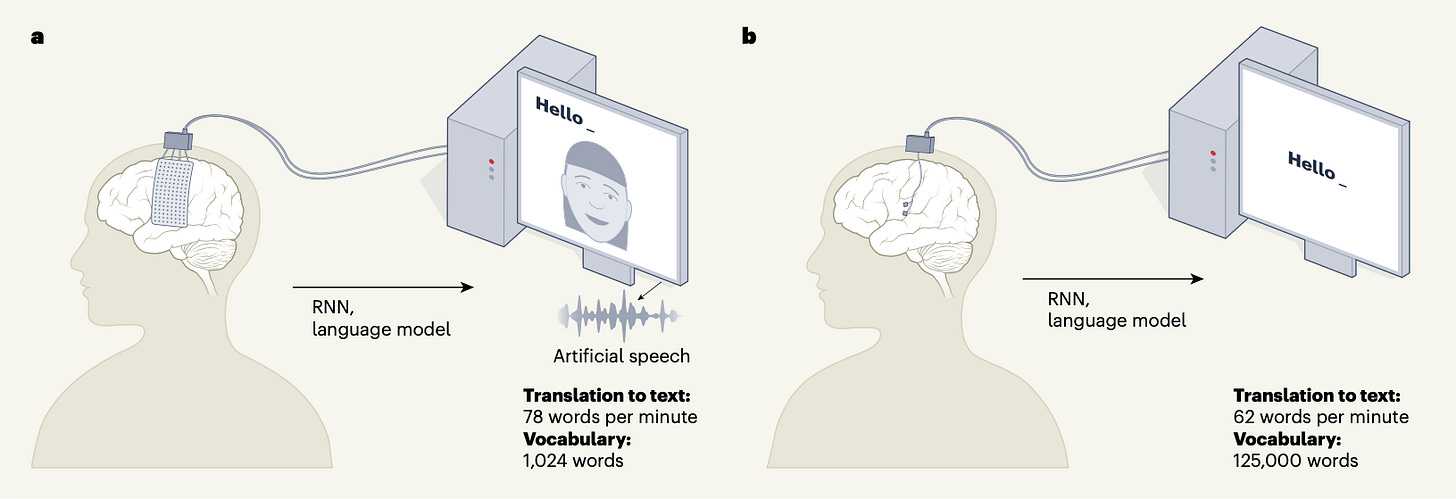Week 191
Brain-Computer Interface, Adolescent Idiopathic Scoliosis, Personalized Screening, Colorectal Cancer
We are moving our newsletter to Substack for a better experience!
In Week #191 of the Doctor Penguin newsletter, the following papers caught our attention:
1. Brain-Computer Interface. Two brain-computer interfaces (BCIs) have been developed that translate brain signals into sentences at near-normal speech speeds, and with vocabularies over 1,000 words.
Metzger et al. and Willett et al. provided proof of concept of using implantable BCIs to restore communication in individuals who cannot speak intelligibly as a result of paralysis. Both studies record brain activity via implanted BCIs and then use recurrent neural networks to convert the brain activity to text, followed by using language models to compose sentences. Metzger and colleagues' BCI uses electrodes on a wide area of the brain's cortex to record brain activity. Willett and colleagues' device uses microelectrode arrays implanted into the cortex to record fewer neurons. It remains to be seen which BCI approach will best serve the needs of users in terms of safety and long-term efficacy in real-life applications.
Nature
Read News & views
Read Metzger et al.
Read Willett et al.
2. Adolescent Idiopathic Scoliosis. Adolescent idiopathic scoliosis (AIS) involves abnormal sideways spinal curving in youth 10-18 years old. Monitoring AIS progression requires repeated radiographs, which may result in unwanted consequences of increased radioexposure.
Zhang et al. developed a deep learning model to monitor AIS using only smartphone photos, without the need for specific backgrounds or medical equipment. On prospectively collected photos of AIS patients taken by their parents/guardians, the model showed similar or better sensitivity and negative prediction value compared to spine surgeons for assessing AIS severity and progression risk. Additionally, an app called AlignProCARE was developed to enable open access to out-of-hospital AIS detection using this model.
JAMA Network Open
3. Personalized Screening. Most breast cancers are diagnosed in women without known clinical risk factors, and the current clinical risk assessment models tend to estimate lifetime risk at the population level, failing to predict interval cancers.
In this editorial, Poynton and Slanetz review advances in image-based AI for breast cancer risk assessment. They point out that models based on textures (such as breast density, mammographic tissue patterns, glandular volume...) are good at predicting long-term risk, and models based on detecting early signs of breast cancer invisible to the human eye are good at predicting short-term risk. Combining AI models that capture long- and short-term risk outperforms the independent models as well as clinical risk assessment models. In summary, image-based AI risk prediction has demonstrated the potential to individualize screening by determining when a woman should start screening, the optimal frequency for screening, and possibly when to delay or avoid screening.
Radiology
4. Colorectal Cancer. Advanced adenomas have a high risk of progressing to interval colorectal cancer. However, recent studies show that computer-aided detection (CADe) did not improve the detection of advanced adenomas.
A systematic review of 21 randomized trials by Hassan et al. confirmed that CADe-assisted colonoscopy improved adenoma detection rate versus standard colonoscopy. However, CADe did not improve the detection of advanced adenomas, and it increased the unnecessary removal of nonneoplastic polyps. Similarly, a large randomized controlled trial conducted by Mangas-Sanjuan involving 3213 participants with a positive fecal immunochemical test also showed that CADe did not improve the identification of advanced colorectal neoplasias during colonoscopy.
Annals of Internal Medicine
Read the editorial
Read Hassan et al.
Read Mangas-Sanjuan et al.
-- Emma Chen, Pranav Rajpurkar & Eric Topol

